ISSN ONLINE(2319-8753)PRINT(2347-6710)
ISSN ONLINE(2319-8753)PRINT(2347-6710)
Shishir Bansal1, S K Singh2
|
| Related article at Pubmed, Scholar Google |
Visit for more related articles at International Journal of Innovative Research in Science, Engineering and Technology
With the growth of society on all the fronts, lot of construction activities are seen everywhere. Mega construction activities are increasing exponentially. Also, the demolition of existing structures, which have outlived its service life, is going on simultaneously. It is not essential that the structures need to be demolished only after their service life span is over, but also due to ongoing trend of reconstruction of even healthy structures just for creating more space in order to meet the present requirement. All such activities are generating huge amount of waste, called the Construction and Demolition (C&D) waste. Disposal of such debris in a sustainable manner is a big challenge for the builders, developers and owners. While the disposal of debris is a challenge, on the other hand there is an acute shortage of naturally available aggregates for construction of buildings. Reduction of this demand in a small way is possible with the reusing or recycling of construction and demolition waste generated from the construction activities. Hence, the construction sector must accept the use of C& D waste wherever feasible
Keywords |
| Construction & Demolition, Recycling, Sustainability, Waste management. |
INTRODUCTION |
| The concept of C& D waste management is new and it is essentially required to spread the education and information in order to gain the public support. The present mindset of public and their attitude towards the waste generated from construction and demolition sites is required to be changed which is possible only with the education in this field. It is required to sensitise not only the Engineers, but all stakeholders including regulatory authorities in construction industry. One must understand the reuse potential of C& D waste and existing practices in implementation and enforcement for achieving the aim with an ultimate motive of Environmental sustainability. Recycling cost is influenced by transportation distance and amount of waste concrete to be recycled. CO2 emission is influenced by transportation distance. It is important to minimize C&D waste generation and maximize reuse/recycling as the construction industry is consumer of tremendous amount of natural resources and energy as well as emitter of GHGs. Establishment of effective strategies and enactment of laws and regulations is essential to achieve this. In addition, provision for some incentives to users of the recycled products deems to be necessary to promote the use. It is essential to assess the life-cycle as it provides quantitative tool to assess environmental impact of C&D waste reuse/recycling. The work in this paper is divided mainly in three stages. Section II explains the reuse and recycling potential of different C&D waste products. Simple guidelines to be followed in recycling the wastes are covered in section III. C&D waste recycling facilities in Delhi are furnished in Section IV, while the waste recycling in global forum is covered under Section V with specific examples of Korea and Japan. Finally, Section VI presents conclusion. |
II. REUSING AND RECYCLING POTENTIAL OF DIFFERENT C&D WASTE |
| Reusing of construction and Demolition waste is different from Recycling. Reusing does not require any further processing to convert into a useful product. The items which are usable directly are screened out from the debris and put into the intended use without further processing or further energy input for conversion into the useful product. For example, full bricks can be screened out of the demolition debris and used as it is for building a partition walls. Otherwise for recycling, it would have been converted into smaller pieces for using it as an aggregate or brick bats for plinth protection etc. Since the reusing of C&D waste is always more advantageous, it is essential that to identify and segregate more and more reusable materials in debris. This is possible, if sufficient precautions are taken while a building is demolished. There should be an effective deconstruction plan instead of just converting the standing structure into debris within minutes. Useful products like doors and windows, bricks, reinforcement, from RCC components, structural steel can be taken out with little extra efforts and put into reuse without much processing. Once the reusable items are taken out, the leftover waste is now available for recycling. Recycling of this waste into useful products to extend the service to environment is a challenge. Worldwide in Japan, Korea, Norway, Singapore etc., recycling of such wastes is taking place and we must understand the potential of different waste products for their effective and useful recycling. Different waste products covered under this section are Concrete, Bricks, tiles, Metals and Plastics. |
| 2.1 Concrete Concrete is primarily a composition of cement, coarse aggregates, fine aggregates and water, further processed by addition of industrial products/ by products for enhancing the properties. Engineers are mainly dependent on nature for obtaining the Coarse and Fine aggregates as well as water for the chemical reaction with cement. Scarcity is there for all these naturally occurring materials and need is there to explore alternative sources. Even for the water with required properties, shift is towards the use of waste water after due treatment. One of the alternative sources of coarse aggregates is recycled concrete aggregates (RCA) which are obtained from the processed Construction and Demolition (C&D) waste. During and after the demolition of any concrete structure, the demolished concrete waste is taken to a recycling plant and there crushed into the required sizes which is called the Recycled concrete aggregate (RCA). Sometimes, good sized precast element are also obtained during the demolition, which have a potential of being reused or otherwise, these are also crushed and converted into the recycled aggregates. Thus, use of recycled aggregates can be there with different quantum of their share by suitable replacing the component of naturally occurring aggregates. It will help out not only in meeting the situation where there is acute shortage of natural resources, but also a step towards the sustainability. |
| 2.2 Brick Bricks are important building material in the construction of residential as well as non –residential buildings in every country. It is also a significant component of the total C&D waste on new residential construction sites. Its demand figures are next to concrete as a building material. Bricks are largely treated as waste when broken or damaged from the brick production line or from construction site due to poor internal handling and excessive cutting. Brick is a maintenance-free component of the structure which is durable during the complete service life of the building. The high durability property of the brick makes it environmental friendly in the sense that after the demolition of the structure, it can be reused repeatedly and the left over volume which is non-reusable can be recycled for other beneficial purposes. Generally, a building is not required to be demolished due to deterioration in the Engineering properties of the bricks. It is for different reason or different needs other reasons that the building has outlived its useful/economical service life and required to be replaced with new structure. During the demolition process itself, bricks obtained are stacked for next use in its original form after the removal of mortar which is chiseled out and make the brick ready for reuse or recycling, if not reusable. Bricks, after the removal of the stuck up mortar remain reusable for restoration or for new homes and projects. Recovered bricks can be used like a fresh lot of bricks without any further processing. These can also be laid on as brick pavers or for landscaping or any other artistic creations. Brick paved streets are aesthetically pleasing and rain water also percolates through the pavement. Also, a brick surface is cooler in hot months. These street advantages make bricks a good choice in driveways. Bricks on edge are also sometimes used as economical pavement solutions in smaller compounds. Bricks which cannot be reused directly can be disintegrated into smaller sized aggregates or brick chips to be used as construction materials. These recycled bricks products are strong and durable enough in comparison to the original brick. Bricks from demolition sites can be recycled as Road base and construction fill and also as light weight concrete. Construction debris consisting of bricks can be recycled into brick aggregate through screening, crushing, re-screening and blending, which can then be used as pavement base material by proper mix proportions with cement and fly ash. Brick waste which are not suitable for recycling into the pavement base materials can be used in construction/land fill. Concrete prepared from crushed brick aggregate has good engineering and also better thermal properties but has greater shrinkage than ordinary concrete. Sometimes, during the manufacturing of bricks, due inadequate burning, or sometimes due to over burning, whole lot is turned into the production waste. Though this waste is different from construction and demolition waste, but it can also be recycled like C& D waste and can be suitable used for production of precast elements like paver blocks, kerb stones, interlocking tiles by mixing with cement and using as a concrete mix. |
| 2.3 Tiles Generally, it is difficult to extract tiles from the walls in proper shape and size in order to find them suitable for reuse. It also depends upon the type of the tiles, their life span and the existing conditions. Still tiles extracted from walls, even if these are broken pieces, provide an excellent opportunity to the artists /designers for making murals or other decorative master pieces. Broken tiles can also be used aggregate after crushing. If the tiles can be extracted or removed from the wall in good shape and size, these are reused for the same purpose after the removal stuck up mortar and then glued with suitable adhesives available in market today. Creative items like artifacts, table tops, special effects in drive ways, pedestrian subways etc. can be smartly created by reusing for a wide variety of projects. Nek Chand’s Rock Garden in Chandigarh, which is internationally renowned, is a perfect example of such reuses.The broken tiles can be further crushed into smaller sizes and can be a partial replacement of gravel and crushed stone in making concrete. |
| 2.4 Timber The waste timber is not only produced from the demolition of the building, but also from construction of wooden building wherein lot of timber waste is generated. Each source has its own system of recycling and reuse of recovered timber from the demolition of a building or the construction of a building. Whenever a building is decided to be dismantled, timber products like doors and windows are the items which are removed as first step and that too in original form. Timber products have a quality of a long service life which is much longer than the life of the building itself. Hence, in general such products unless eaten by the termites or damaged due to fire do not lose the Engineering properties for a long time and can be used multiple times and thus an environmentally friendly product. The waste timber which does not been recovered in its original form or non-usable in same shape and size, can be recycled into new particleboard, medium density fibre boards, animal bedding or used to make renewable energy. Timber used for recycling has to be free from any other demolition products like concrete, mortar, aggregates, sand, bricks, plastic, metals, tiles etc. Wood chips are produced from good quality wooden waste such as large size lumbers. Some of the particleboard producing companies and the pulp and paper producing companies are still using the recycled chip for their products. Chipped or shredded wood is also used as a sewage sludge bulking medium and other products lime pallets. |
| 2.5 Metals Amongst the metals, steel and Aluminium are the two major products obtained as waste during the construction as well during the demolition of a building. Structural steel obtained during the demolition of a steel structure or left over steel during the construction can be reused directly without much processing. The members can be resized as op the requirement and can be reused directly. Aluminium scrap can be put into reuse by the solid bonding process. If a care is taken in initial stages i.e. during designing with a valid deconstruction plan, then the reusable scrape can be increased to a much greater extent like house hold appliances, without taking the routing the scrap through a foundry. Reusing a steel beam its existing form is better than re-melting it and rolling a new steel beam, i.e. the energy used to re-melt the beam is saved. Steel waste occurs during the construction and refurbishment of buildings and when they are ultimately demolished and the material becomes available for recycling. Waste from the manufacture of steel construction products can be easily collected and segregated for recycling. Steel generates almost nil wastage on the construction site. Waste steel which is reusable is equally good in durability criteria and the quality is also well maintained while making products like fire hydrants, steel furniture and also ecologically sustainable. As far as Aluminium is concerned, it is recyclable multiple times and is always on demand with the need to preserve the environment. Our raw materials vary considerably based on whether we are using pr imary or recycled aluminum. We must take into account the different sustainability impacts of sourcing primary aluminum from the mined substance bauxite, or recycled aluminum from either pre- or post-consumer sources. Recycling scrap aluminium requires very less energy in comparison to the energy requirement of new aluminium. Because aluminum is infinitely recyclable, it can be reused in applications vastly different from its previous purpose, and it can also be recast into its original form. These properties make aluminum an ideal material for use in premium applications, even after being recycled many times. |
| 2.6 Plastic Scrap or waste plastic recovered from demolition or construction site is reprocessed and transformed into the entirely different useful products. Typically a plastic is not recycled into the same type of plastic, and products made from recycled plastics are often not recyclable. When compared to other materials like glass and metals, plastic polymers require greater processing to be recycled. The most-often recycled plastic HDPE (high-density polyethylene) is reduced to plastic lumber, tables, roadside curbs, benches, truck cargo liners, stationery (e.g. rulers) and other durable plastic products and is usually in demand. Other application of recycled plastic is in the preparation of a road surface that includes recycled plastic: aggregate, bitumen (asphalt) with plastic that has been shredded and melted at a temperature below 220° C (428 °F) to avoid pollution. Such road surfaces are very durable and monsoon rain resistant. |
III. SIMPLE GUIDELINES TO BE FOLLOWED IN RECYCLING OF DEMOLITION WASTE |
| The agencies responsible for generation of wastes should separate the generated wastes having potential for reuse/recycling. The Engineer-in-charge will select structure’s type and materials that are suitable for reuse/recycling, use recycled aggregates, and ensure proper treatment of wastes generated from such development. The waste generation from construction should not only be minimised, but should also minimise the hazardous effect from the generated wastes. |
| 3.1 Agencies (or sub-contractors) Various agencies or sub-contractors to be involved are to be linked up with the steps in this process of C& D waste reuse and recycling. Some of such steps can be listed as waste collection and transportation, intermediate waste treatment i.e. receiving the waste, its segregation and further suitable comprehensive treatment before putting into the use. The cost for C&D waste separation, storage, treatment, reuse/recycling should be included in the Estimated Cost by the Engineer-in-charge while according Technical sanction and preparing tender documents. There are important duties to be either assigned or as a dutiful contractor, he may be establishing himself like, he should establish step-by-step demolition plan. Contractor may establish treatment facility at site only. He should report expected amount of wastes by type and treatment plan at the beginning of construction. There should be effective utilization of recycled aggregates and Safe treatment of hazardous waste like asbestos. Contractor may be asked to submit Environmental Management Plan during Construction. |
| 3.2 C&D waste information on web All C&D waste information by contractor and by those involved in its treatment waste treatment companies are to be put on public domain in order to improve the rate of use of demolished concrete for e.g. application of recycled aggregates. Further to have a stronger data base of C&D waste, users reusing the C&D waste or recycled waste after treatment and processing can contribute a lot. This will help in substantial reduction on the amount of wastes and promotion of recycling or reusing the C&D waste. |
| 3.3 Demolition Plan It is required to adopt a systematic approach while demolishing a building in order to minimise the waste and its best use. A recommended approach can be to follow a sequence of segregation of household waste as first step followed by mechanical and electrical equipment, exterior and interior finishing materials, roof finishing and water -proofing materials, then structure as a last resort. Demolished C&D wastes need to be brought out of field immediately or temporarily stored in a designated area for the C&D wastes. |
IV. C&D WASTE RECYCLING FACILITY IN NEW DELHI |
| At present, in India, the recycling of Construction and Demolition waste has started now only and we have to go a long way in this direction. In New Delhi, 1st pilot plant is functioning at Burari in North Delhi, but it requires many such plants to fulfil the needs in Delhi looking at the recycling potential of waste generated daily in New Delhi. About 5000 MT of recyclable waste is believed to be generated daily in New Delhi. Fig. 1 shows the one pilot plant set up IL&FS Environmental Infrastructure and Facilities Ltd. for North Delhi Municipal Corporation is functioning at Burari, Delhi. |
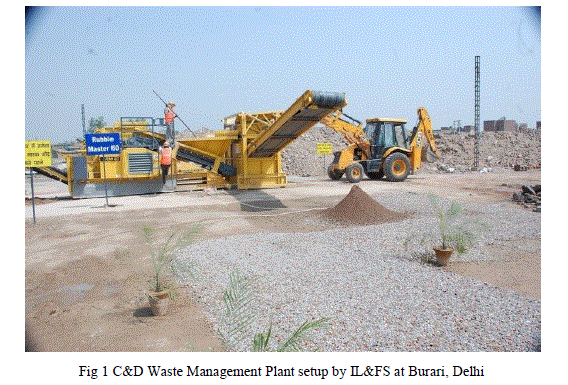 |
| After the collection of Construction and Demolition waste, the material is routed through the Weighbridge to the processing site, wherein silt and loose soil is separated and used for land filling. Processed C&D waste is used for sub base of roads and for making bricks, paver blocks & kerb stones. The capacity of the plant is 500 T per day. |
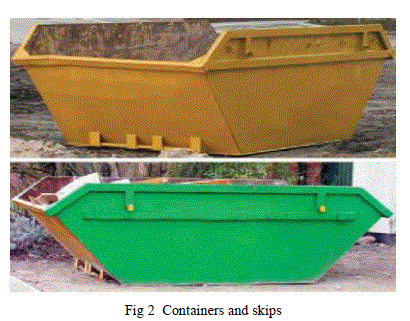 |
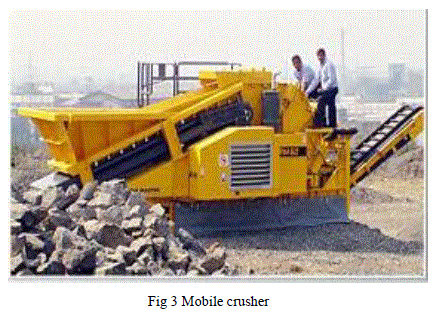 |
| There are designated collection points where containers and skips (Fig. 2) are placed as a first storage point of C&D waste where the waste is brought in by private persons. As an additional measure, sufficient vehicles are also in operation to collect the waste from various locations of the city as per the services required from pick up points. In 2012, 153000 T of C&D waste has been processed for making useful products. Out of this 11700 T of aggregates, 5632 T of Granular sub-base and 4289 T of sand has been produced. Further, 2000 cum of cast products and 6000 Cum of Ready Mix Concrete has been produced in this plant in 2012. Fig. 4 shows the Pavement Blocks and Kerb stones being produced at Burari Plant. |
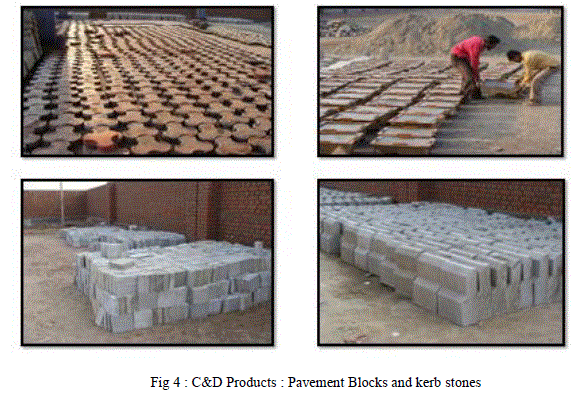 |
V. GLOBAL SCENARIO OF HANDLING C & D WASTE |
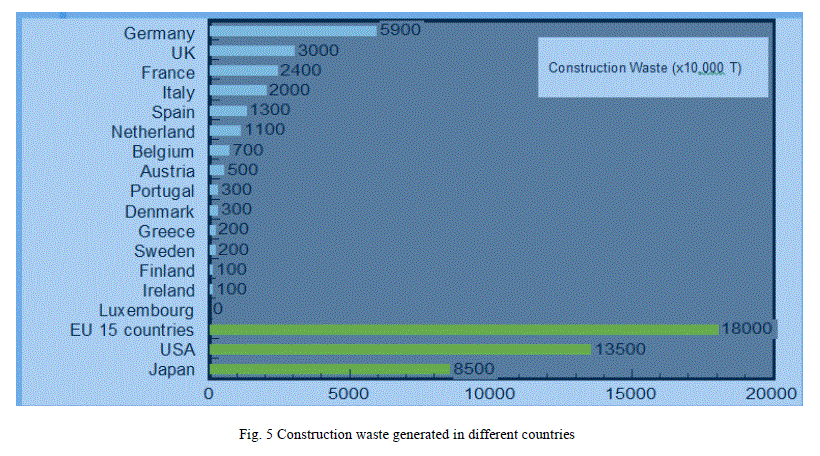 |
| An assessment if constructed waste generated in different countries has been shown in Fig. 5. A brief study of processing of C& D waste in Korea and Japan has been covered in this section |
5.1 C&D WASTE RECYCLING IN Korea |
| As per the objectives of the 1st National C&D Waste Management Plan (2007-2011) in Korea, it included C&D waste reduction by step-by-step demolition, C&D wastes generated in the field and those received by waste treatment companies to be registered in the national waste information management system (ALLBARO, www.allbaro.or.kr), an effective utilization of recycled aggregates and Safe treatment of hazardous waste (e.g. asbestos). As an achievement of the Plan, now, all C&D waste information by constructor and waste treatment companies are recorded on-line and the rate of use of demolished concrete (e.g. application of recycled aggregates) has drastically improved. Further the Objectives of the 2nd National C&D Waste Management Plan (2012-2016), included improvement on the national waste information management, additional data input by the user of treated wastes, construction of life-cycle inventory data of C&D wastes and reduction on the amount of mixed wastes. In 2009, total C&D waste generation was 67 million tons which was 51.2% of all wastes (131 million tons). C&D wastes are largely divided into 4 groups: (1) concrete, asphalt concrete, bricks, blocks, etc., (2) non-combustible wastes other than concrete and bricks, (3) combustible wastes and (4) mixed wastes. |
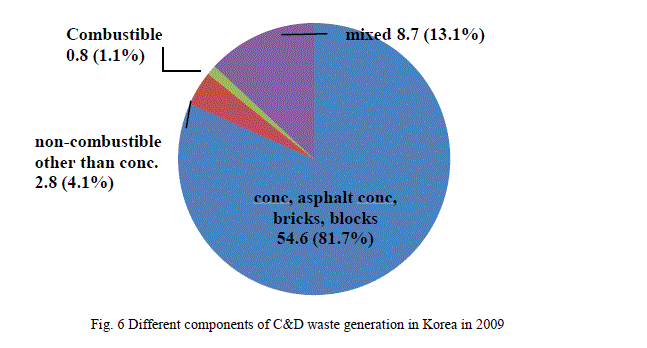 |
| In 2009, 42.1 million tons of demolished concrete was generated which is63% of all C&D wastes and effective recycling rate was 36% (definition of effective recycling: usage on road sub-base construction or equivalent, concrete blocks, and recycled aggregate for concrete). Concrete products such as concrete blocks were 6% and production of concrete as recycled aggregates was 1.5%. |
 |
| Method of application of recycled aggregates for concrete Concrete having compressive strength of more than 21 MPa prepared with natural and partly RCA as coarse aggregates, but fineaggregates from natural source only were put into use as column, girders, slab, load bearing walls etc.. Where thecompressive strength was lesser than 21 MPa and fine aggregates also consistof partly RCA, its use was limited to concrete blocks, road base, filler material for concrete etc. |
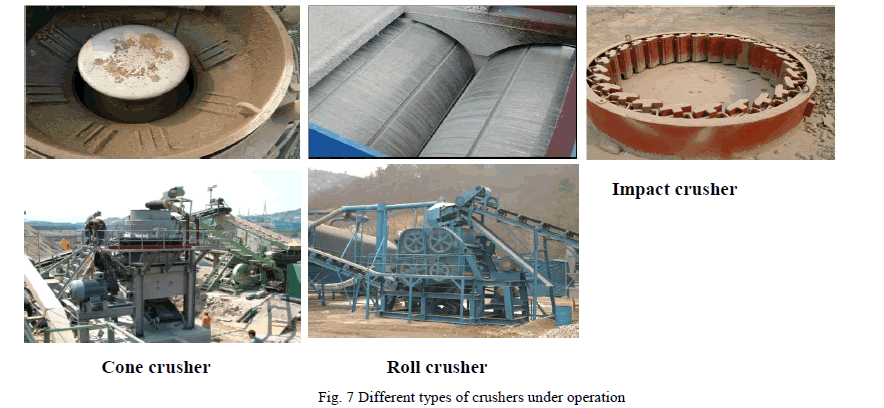 |
5.2 C&D WASTE RECYCLING IN JAPAN |
| As per the basic philosophy followed in Japan, viewpoint of environmental conservation must be added to price and quality, selection making is based on diverse viewpoints, including formation of socio-economic system withenvironmentally sound material cycle and combating global warming, consideration is given to reducing environmental impact throughout the product lifecycle, from manufacture to disposal and a commitment to long-term use, correct utilization, and sorted disposal of procured goods. Aggregate, 70% by volume of concrete, anticipated as a recipient of waste and by-products from other industries. |
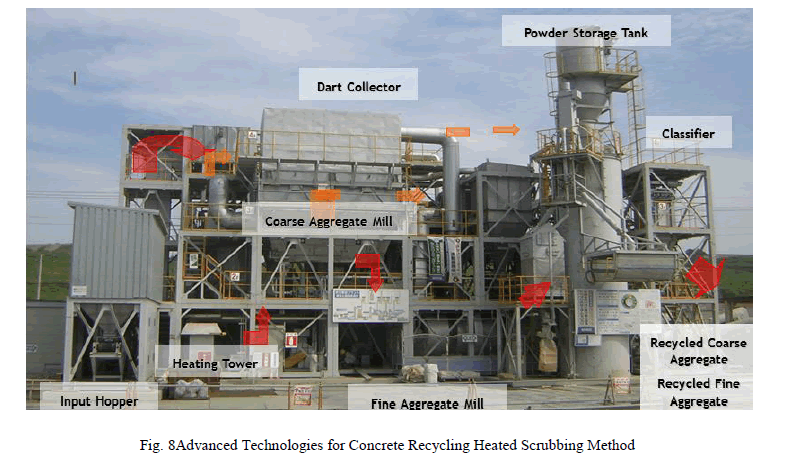 |
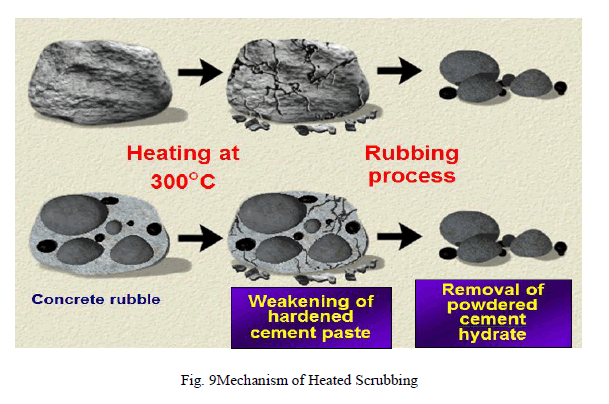 |
| Japan Industrial Standards define three classes of concrete depending upon the properties of recycled Coarse and Fine aggregates Class H : Having density of Coarse and Fine aggregates more than 2500 Kg/cum. Water absorption lesser than 3% for Coarse aggregates and lesser than 3.5 % for fine aggregates. Such products are put into use without any limitation for concrete strength upto 45 MPa Class M : Having density of Coarse more than 2300 Kg/cum and of Fine aggregates more than 2200 Kg/cum. Water absorption lesser than 5% for Coarse aggregates and lesser than 7 % for fine aggregates. Such products are allowed to be used where members are not subjected to drying or freezing and thaw action like piles, underground beams and concrete filled in steel tubes. Class L : Having Water absorption lesser than 7% for Coarse aggregates and lesser than 13 % for fine aggregates. Such products are used only as backfill concrete, blinding concrete and leveling concrete. |
VI. CONCLUSION |
| Concrete has become a high tech material and its production is used by economists as a measure of a country’s economic strength. Aggregates from natural sources are getting scarce over the years. The situation has forced us to explore aggregate from alternate sources. It is important to minimize C&D waste generation and maximize reuse/recycling as the construction industry is consumer of tremendous amount of natural resources. In view of international developments and experiences, as well as shortage of aggregate from natural sources being experienced in many parts of the country, it is time that recycled aggregate are permitted for use in concrete constructions. The Municipal bye-laws are required to be reviewed and suitably modified. Establishment of effective strategies and enactment of laws and regulations are essential to achieve this. In addition, provisions of some incentives to users of the recycled products are necessary to promote the use. Research & Development is to be promoted by Government. There is lack of public awareness and it is required to spread the Information, Education and Communication in order to Garner Public Support and change the attitude of Public and Staff. Data and results should to be posted in Public Domain. Material flow should be further optimised in cooperation with other industries as part of the resource recycling of society as a whole, reflecting back on the abundant resource consumption of concrete and the long service lives of buildings and civil structures. |
| As a matter of Principle, recycling should be of high quality. Recycled products are not marketable unless they are of a quality that satisfies users. Recycling should be repeatable. If a recycled product has to be dumped in a landfill after use with no chance of recycling, then the recycling is no better than producing waste of the following generation. |
References |
|